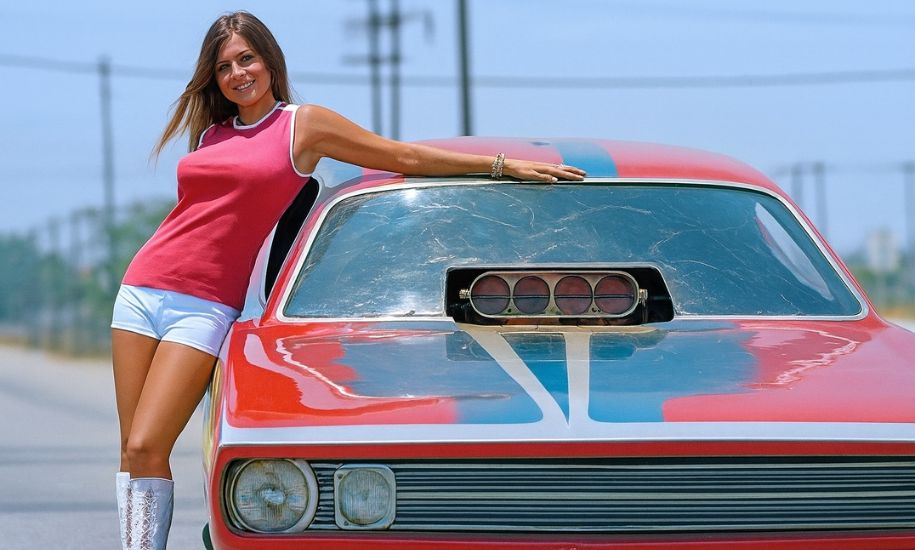In the history of American motorsports, much has been written about the great drivers, legendary machines, and landmark races. Yet beyond the roar of engines and the chase for trophies lies another side of the culture—one that combined glamour, fashion, and public spectacle. Within this cultural landscape of the late 1960s and early 1970s, Barbara Roufs emerged as a striking figure. She was not a professional driver, nor a car builder, but a trophy girl—one of the most recognizable promotional personalities of her time. For many, Barbara Roufs became a symbol of beauty, style, and excitement during drag racing’s golden era. Decades after her passing, she is still remembered with nostalgia, fascination, and a tinge of sadness.
This article explores the central questions: Who is Barbara Roufs? and How is Barbara Roufs remembered? By revisiting her background, career, personal struggles, and legacy, we can better understand why her name continues to surface in conversations about motorsport culture and 20th-century Americana.
Who is Barbara Roufs?
Early Life
Barbara Roufs was born in 1944 in California, a state that would later become central to her public life. She grew up in a family with several siblings and had parents rooted in working-class values. Her father, Wayne Eldon Riley, and her mother, Thelma Ruby Riley, raised her alongside both biological and adopted siblings. While not much is known about her early schooling or youth, Barbara’s childhood in post-war California placed her in a region buzzing with emerging car culture, hot rod enthusiasm, and drag racing.
By her twenties, Barbara stood out for her distinctive look—long straight hair, an athletic yet feminine build, and a vibrant personality that naturally suited promotional work. The motorsport industry, particularly drag racing, soon became her platform.
Career as a Trophy Girl
Barbara Roufs rose to public attention as a trophy girl in the Southern California drag racing scene during the late 1960s and early 1970s. For context, “trophy girls” were promotional models who appeared at races, award ceremonies, and publicity events, typically presenting trophies to winners. At a time when motorsports were overwhelmingly male-dominated, the presence of stylish, glamorous women added an element of allure and fanfare.
Roufs was not just another face in the crowd. She quickly became one of the most recognizable figures at events like the Professional Dragster Association (PDA) meets and the Orange County International Raceway competitions. Her charm, combined with a commanding stage presence, elevated her to the role of “queen” at dragster championships. She often appeared in gogo boots, miniskirts, and bold makeup, embodying the era’s countercultural fashion.
Her work as a trophy girl may not have involved engines or lap times, but her role was significant. In many ways, she represented the blend of motorsport with popular culture—bringing visibility to events that competed with rock concerts and Hollywood premieres for attention.
Personal Life
While Roufs projected glamour in public, her private life was more grounded. She became a mother at age 29, giving birth to her daughter Jet Dougherty. Accounts suggest that Barbara loved her family deeply and maintained a strong bond with her siblings and child.
However, much of her personal life was not widely documented. Like many promotional models of her time, her fame was tied closely to appearances at specific events. Once she stepped away from the drag racing scene, her visibility in the public sphere diminished.

Death and Mystery
Barbara Roufs’s story took a tragic turn in January 1991, when she died at the age of 46. Multiple sources cite her death as a suicide, though details remain unclear. This lack of confirmed information has left her life shrouded in mystery.
Why did someone who once captivated audiences with energy and style die in such circumstances? Some speculate that she struggled with personal challenges, possibly related to the fleeting nature of fame, financial pressures, or hidden emotional battles. Others emphasize that without verified records, any attempt at explanation risks oversimplification.
What is certain is that her death left behind not just sorrow for her family, but also a sense of cultural loss within the racing community.
How is Barbara Roufs Remembered?
Despite the brevity of her public career, Barbara Roufs’s image and memory continue to resonate. Enthusiasts and cultural historians remember her in several ways:
1. A Symbol of Beauty and Style
Barbara Roufs is remembered first and foremost for her striking appearance. With her long hair, youthful energy, and vibrant fashion choices, she represented an aesthetic that captured the spirit of the 1970s. Many racing fans recall her as one of the most beautiful trophy girls of her era. Photographs from events, often resurfacing in magazines or online retrospectives, show her in bold outfits that mirrored the countercultural confidence of the time.
2. A Cultural Figure in Drag Racing
Although she never drove professionally, Roufs is considered part of drag racing’s heritage. The sport itself was at a cultural crossroads during the late ’60s and early ’70s. Cars were bigger, louder, and faster; crowds were swelling; and television exposure was increasing. Trophy girls like Barbara helped package the sport for public consumption, making events not just competitions but spectacles.
Roufs, in particular, became the face of multiple drag events, including the U.S. Professional Dragster Championship, where she was crowned queen. Her role ensured that she was photographed, reported on, and remembered alongside the drivers themselves.
3. A Figure of Tragedy
Barbara Roufs is also remembered through the lens of tragedy. The circumstances of her death highlight the vulnerabilities behind glamorous images. To many fans, her story serves as a reminder that public adoration can mask private struggles. The idea that a woman so admired could end her life so early has led to enduring speculation and sorrow.
4. Nostalgia for a Bygone Era
Perhaps most significantly, Roufs is remembered as part of the nostalgic fabric of drag racing’s golden age. Enthusiasts often look back on the 1960s and 1970s as a unique time when racing was raw, unfiltered, and culturally intertwined with rock ’n’ roll, fashion, and youthful rebellion. Barbara Roufs, with her iconic look and brief but impactful career, is often evoked as a symbol of that golden age. Her photographs, when shared today, evoke not just admiration for her beauty but also longing for a simpler, more vibrant era in motorsports.
Legacy in Popular Culture
Today, Barbara Roufs’s legacy survives through blog articles, vintage photo archives, and racing fan communities. Websites recount her story, often with varying details, but united in admiration. Her daughter, Jet Dougherty, has occasionally been mentioned in these retellings, underscoring the human legacy she left behind.
The fascination with Barbara Roufs also speaks to broader cultural dynamics. She represents the many women whose contributions to sports and entertainment were overlooked because they did not fit traditional roles. Her visibility reminds us that motorsport was never only about cars—it was also about culture, fashion, and personality.
Conclusion: Barbara Roufs’s Enduring Memory
So, who is Barbara Roufs? She was more than a trophy girl. She was a mother, a daughter, a sister, and a cultural icon whose beauty and energy enlivened drag racing during its most colorful years.
And how is Barbara Roufs remembered? With admiration, nostalgia, and sadness. Admired for her beauty and poise, remembered as part of drag racing’s golden spectacle, and mourned for a life cut short by tragedy.
Though her story is fragmented and her life’s records incomplete, Barbara Roufs continues to live in the cultural memory of motorsport fans and cultural historians alike. Her name surfaces whenever we speak of drag racing’s glamour years, ensuring she remains part of that history.
At Tumblr Magazine, we believe her story is worth retelling—not only as a tale of beauty and tragedy but as a reminder of the women who shaped motorsport culture in subtle yet powerful ways.
For more information visit Tumblr Magazine .







